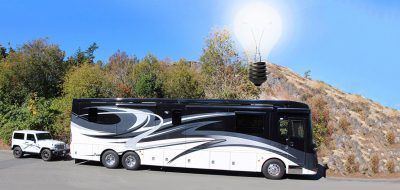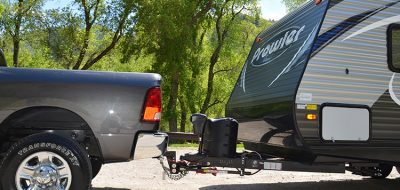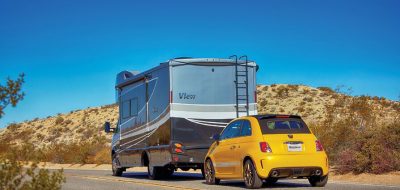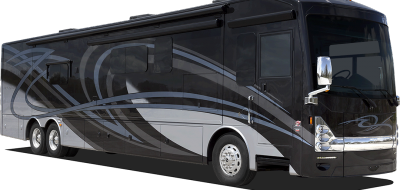Understanding the difference and the advantages of different hitch types is essential to choosing a towable RV.
The right hitch and accessories makes towing a trailer or fifth-wheel safe and easy, leveling the truck and trailer, equalizing the load and controlling sway.
When you think of RVing, what image comes to mind? For many, it’s a Class A or C motorhome headed down the highway. However, many RVers prefer to pull their “palace on wheels” behind them. Towable RVs offer several advantages. By using a car, truck, van or SUV that you already own as a tow vehicle, you save the extra costs of a motorized RV. Once you arrive at your destination, just unhitch and you have transportation for sightseeing, shopping and exploring. And because no space inside the RV is lost to engine or driver accommodations, a towable RV offers more living space than a motorized RV of the same length.
Towing a trailer isn’t hard but it involves more than just hitching up and heading out. It’s important to understand how the connection between your tow vehicle and trailer— the hitch—works before choosing a travel trailer or 5th wheel.
Which Hitch is Which?
Frame hitches are used to tow travel trailers and pop-up campers. The frame hitch, or ball and coupler hitch, consists of a hitch receiver that attaches to the tow vehicle’s frame, a ball mount that inserts into the receiver and a hitch ball that bolts to the ball mount. The trailer tongue slips over the hitch ball and secures to tow the trailer.
There are two basic types of frame hitches. The Weight Carrying Hitch supports the entire tongue weight of the trailer on the car, truck, van or SUV rear axle. Because of this, weight carrying hitches are only recommended for use with light to medium weight trailers. The Weight Distributing Hitch uses equalizing bars to apply leverage between the tow vehicle and trailer, helping to distribute the trailer’s tongue weight evenly between the front and rear axles of the tow vehicle. This allows these hitches to accommodate heavier trailers. Many weight carrying hitches can be outfitted with weight distributing systems, equipping them to haul heavier loads safely. An anti-sway system can be added to either type movement of a trailer under tow, improving driver control and safety.
A 5th wheel hitch is installed in the pickup bed over the rear axle, and bolts to the truck frame through the bed floor. A rail kit is installed inside the truck bed to mount the hitch. The hitch pin or kingpin on the trailer is inserted into the hitch and held in place with the plate jaws. This setup works without any problems for long bed trucks; however, short bed trucks require a pin box extension (which lengthens the distance between the truck and trailer) and/or a sliding hitch (which allows the hitch center to slide farther back toward the trailer when maneuvering) to give more turning clearance.
The Right Hitch for You
Many RVers prefer a frame hitch and travel trailer because of the flexibility of towing options. Unlike a 5th wheel, a travel trailer with a frame hitch can be attached to cars, trucks, vans and SUVs. Since frame hitches do not interfere with bed space, the truck bed can be fully utilized for storage space or tool boxes if you tow with a pickup. Travel trailers pulled by frame hitches are usually much lighter than 5th wheels; the lighter tow load may result in better fuel economy.
The 5th wheel hitch and trailer offers several inherent advantages over other types of towable RVs, the most important of which is its stability. Having the trailer’s tongue weight over the rear axle of the truck improves both handling and road traction, so you enjoy a smoother, more stable ride. Because the 5th wheel hitch connects in the bed of the truck, the overall length of the rig is shorter than that of a travel trailer with equivalent floor space. Most RVers also find that 5th wheel hitches are much easier to hitch and unhitch than a frame hitch, due to improved visibility of the hitch and kingpin while aligning truck and trailer. A unique advantage of the 5th wheel is that once unhitched, the area under the raised gooseneck section can be converted into a large storage space using a 5th wheel skirt.
Safety First
Regardless of what hitch you may be using, safety should always come first. Never attempt to tow any trailer that exceeds your tow vehicle’s maximum tow rating, as listed in the owner’s manual.
Any trailer that you tow should be properly equipped with a wiring harness to control the trailer’s lights and brakes. You also need a brake controller to monitor your tow vehicle’s braking patterns and activate the trailer’s electric brake.
Safety chains are another must-have accessory. Chains should always be securely connected between the trailer tongue and frame hitch receiver and should be long enough to allow tight turns without dragging when towing in a straight line.
Road vision is paramount. Stock mirrors on your tow vehicle simply weren’t meant to accommodate trailer towing. To see around your rig for safe backing, passing and merging, you may opt to replace your tow vehicle’s factory side-view mirrors with aftermarket mirrors to extend your vision.





